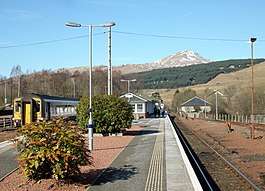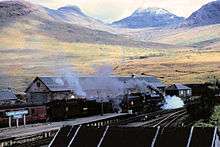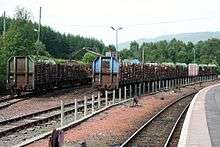Crianlarich railway station
Crianlarich railway station is a railway station serving the village of Crianlarich in Scotland. It is located on the West Highland Line. The routes to Fort William/Mallaig and Oban diverge after this station. Access to the platform is via a flight of stairs from a subway that runs underneath the tracks, from the car park which is slightly lower than the station itself.
| Crianlarich | |
|---|---|
| Scottish Gaelic: A' Chrìon-Làraich[1] | |
 Looking north towards Tyndrum | |
| Location | |
| Place | Crianlarich |
| Local authority | Stirling |
| Coordinates | 56.3903°N 4.6185°W |
| Grid reference | NN384251 |
| Operations | |
| Station code | CNR |
| Managed by | Abellio ScotRail |
| Number of platforms | 2 |
| Live arrivals/departures, station information and onward connections from National Rail Enquiries | |
| Annual rail passenger usage* | |
| 2014/15 | |
| – Interchange | |
| 2015/16 | |
| – Interchange | |
| 2016/17 | |
| – Interchange | |
| 2017/18 | |
| – Interchange | |
| 2018/19 | |
| – Interchange | |
| History | |
| Original company | West Highland Railway |
| Pre-grouping | North British Railway |
| Post-grouping | LNER |
| 7 August 1894 | Opened |
| 1953 | Suffix "Upper" added to station name. |
| After 1965 | Suffix "Upper" removed from station name. |
| National Rail – UK railway stations | |
| * Annual estimated passenger usage based on sales of tickets in stated financial year(s) which end or originate at Crianlarich from Office of Rail and Road statistics. Methodology may vary year on year. | |
History

Crianlarich station opened concurrently with the West Highland Railway on 7 August 1894,[2] doubling the number of railway stations in the village. The lines and station were eventually built by the state under compulsory purchase arrangements sought after the persistent rejection by the landowners the Place family of Loch Dochart House and Skelton Grange, Yorkshire who even turned down the offer of having all the proceeds from the two station tea-rooms in perpetuity. The Places felt that the project would spoil their shooting grounds; the family sold their house and estate shortly after their defeat and retreated to Yorkshire.
The station was laid out with a crossing loop around an island platform and sidings on both sides. On the east side there was an engine shed and a turntable. Three years after opening, in 1897, a junction and link line down to the Callander and Oban Railway, which passed below the West Highland route, was added. Originally, the junction incorporated a scissors crossover, allowing simultaneous moves through the junction. However until 1931 the link line was only used to exchange goods wagons between the two lines. From 1931 onwards, it was also used for excursion traffic from Glasgow and the surrounding areas to the Oban line.
The station was host to a LNER camping coach from 1937 to 1939.[3]
In 1951, British Rail added the suffix "Upper" to the station's name, in order to distinguish it from the nearby station (only about 330-yard (300 m) walk along the north east access road) on the Callander and Oban Line which then became known as Crianlarich Lower.[2]
Since closure of the Callander and Oban Line east of Crianlarich in 1965 due to a landslide that submerged the railway in Glen Ogle, all trains to Oban have been routed up the West Highland Line as far as Crianlarich Upper station. They then join the remaining part of the Oban line by means of the link line, which had formerly been infrequently used.
Crianlarich Lower station closed on 28 September 1965, and on 1 November 1965 the Upper station's name reverted to "Crianlarich".[2]
The late 19th century 13-bay brick engine shed still stands and Historic Scotland have designated it as a category C listed building.[4] It is now used by the Permanent Way engineers.
Services
Northbound, Crianlarich is where the combined trains for Oban and Mallaig divide, with each of the services leaving roughly five minutes apart. Southbound, when each train arrives from Oban or Mallaig, it joins with the other and they go down as one train from Crianlarich. In the summer 2019 timetable, three additional services run to/from Oban only in addition to the trio of combined workings.[5]
Mondays to Saturdays, there are six services to Oban, three to Mallaig and one service to Fort William (Highland Caledonian Sleeper) northbound. Southbound, there are six services to Glasgow Queen Street and one service to London Euston (Highland Caledonian Sleeper, which does not run on Saturday). On Sundays, there are three services to Oban all year and one or two (depending on the time of year) to Mallaig northbound. Southbound, there are four trains to Glasgow Queen Street and one to London Euston (the sleeper calls at Queen Street Low Level & Edinburgh to set down only, as it conveys seated coaches as well as sleeping cars and can thus be used by regular passengers).
| Preceding station | Following station | |||
|---|---|---|---|---|
| Ardlui | Abellio ScotRail West Highland Line |
Tyndrum Lower | ||
| Upper Tyndrum | ||||
| Ardlui | Caledonian Sleeper Highland Caledonian Sleeper |
Upper Tyndrum | ||
| Historical railways | ||||
| Ardlui Line open; Station open |
West Highland Railway North British Railway |
Tyndrum Line open; Station open | ||
| Southern end of link line |
Callander and Oban Railway Crianlarich Link Line Operated by Caledonian Railway |
Tyndrum Lower Line open; Station open | ||
Station building
An independently operated tea room is located in the station building. The station buildings are not the original ones: these (which were of the standard 'West Highland' design) were destroyed by fire in 1937.
Freight facilities

The area around the station is forested. The sidings on the west side of the station were used for loading timber until December 2008 when the carriage of Scottish timber by rail ceased in connection with the recession. As of June 2015, there is still no sign of the service being reinstated. Timber trains leaving the sidings at Crianlarich often paused at Arrochar and Tarbet to attach further wagons, the sidings at both stations are now used by the Area Civil Engineer for the storage of materials.
Signalling
From the time of its opening in 1894, the West Highland Railway was worked throughout by the electric token system. Crianlarich signal box was situated at the north end of the island platform.
In 1967, the method of working between Crianlarich and Rannoch was changed to the Scottish Region Tokenless Block system. In August 1985, the method of working between Crianlarich and Rannoch reverted to the electric token block system.
The semaphore signals were removed in stages during December 1985 in preparation for the introduction of Radio Electronic Token Block (RETB) by British Rail. Track layout alterations were made at the same time, including simplification of the junction and extension of the crossing loop at the south end. The RETB, which is controlled from a Signalling Centre at Banavie railway station, was commissioned from Helensburgh Upper to Upper Tyndrum and Taynuilt on 27 March 1988.[6]
The junction points at the north end of the station are electrically operated and the route selected by means of a plunger at the platform end operated by the train driver. Once the route has been chosen and the points set, the driver returns to his train cab and contacts the Banavie control centre for permission to proceed.[7]
The Train Protection & Warning System was installed in 2003.
Notes
- Brailsford, Martyn, ed. (December 2017) [1987]. "Gaelic/English Station Index". Railway Track Diagrams 1: Scotland & Isle of Man (6th ed.). Frome: Trackmaps. ISBN 978-0-9549866-9-8.CS1 maint: ref=harv (link)
- Quick, Michael (2019) [2001]. Railway passenger stations in Great Britain: a chronology (PDF) (5th ed.). Railway and Canal Historical Society.
- McRae, Andrew (1997). British Railway Camping Coach Holidays: The 1930s & British Railways (London Midland Region). Scenes from the Past: 30 (Part One). Foxline. p. 11. ISBN 1-870119-48-7.
- "CRIANLARICH, CRIANLARICH STATION, ENGINE SHED". Historic Scotland. Retrieved 10 March 2019.
- GB eNRT May 2019 Edition, Table 227 (Network Rail)
- "RETB"Scot-rail.co.uk; Retrieved 27 April 2016
- "RETB Banavie South" Retrieved 27 April 2016
Further reading
| Wikimedia Commons has media related to Crianlarich railway station. |
- Butt, R. V. J. (1995). The Directory of Railway Stations: details every public and private passenger station, halt, platform and stopping place, past and present (1st ed.). Sparkford: Patrick Stephens Ltd. ISBN 978-1-85260-508-7. OCLC 60251199.
- Jowett, Alan (March 1989). Jowett's Railway Atlas of Great Britain and Ireland: From Pre-Grouping to the Present Day (1st ed.). Sparkford: Patrick Stephens Ltd. ISBN 978-1-85260-086-0. OCLC 22311137.